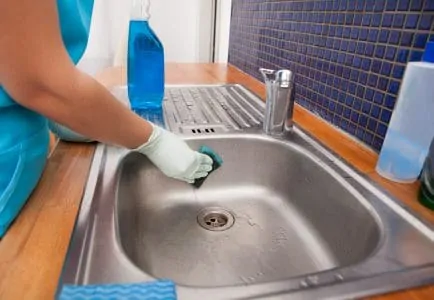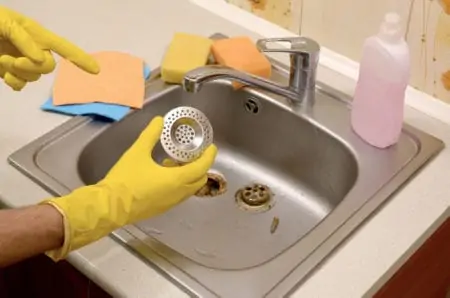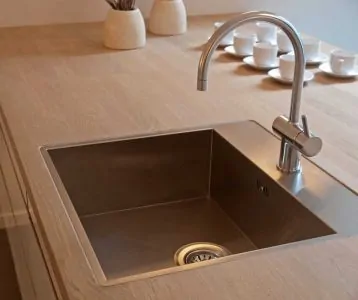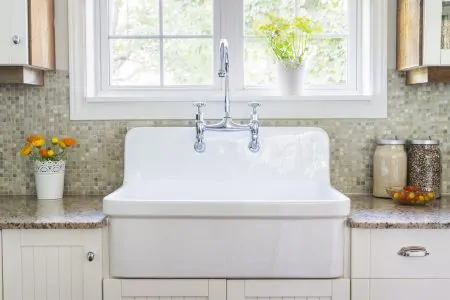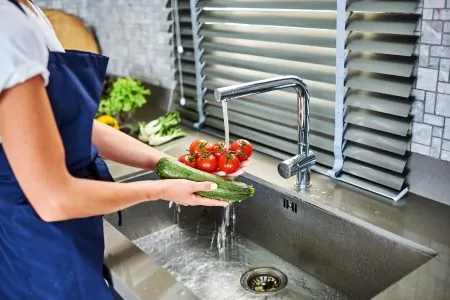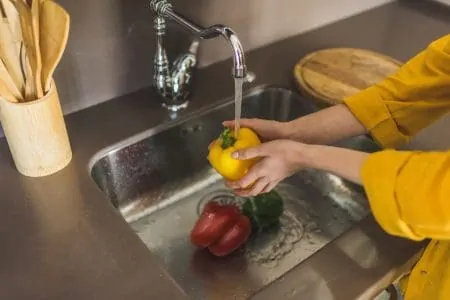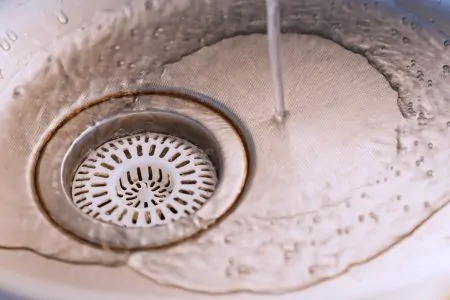Despite its name, stainless steel isn’t immune to becoming dirty or being affected by other issues such as rust. Without proper maintenance, even the best stainless steel sink can become unsightly.
Thankfully, cleaning your sink is quick and simple, and will ensure it stays beautiful for longer. If you are cleaning stainless steel for the first time, you might be unsure which cleaners and tools you can use safely.
In this article, we will explore how to clean a stainless steel sink. We will also look at how to deal with rust and scratches, and how to prevent stains from forming in the first place.
Key Takeaways
- Prevent stains: Keep the sink dry, avoid harsh chemicals, remove acidic food, and clean regularly.
- Clean sink: Use approved cleaners like Bar Keeper’s Friend, a double-sided sponge, and clean cloths for drying.
- Remove rust: Use a baking soda and water mixture, an old toothbrush, and clean cloth to scrub away rust stains.
- Restore shine: All-purpose flour or olive oil can be used to polish the sink and bring back its shine.
- Preventing Stains on Stainless Steel Sinks
- How to Clean a Stainless Steel Sink
- How to Remove Rust from Stainless Steel
- Removing Hard Water Stains from Stainless Steel
- How to Remove Scratches
- How to Clean Stainless Steel Sinks Naturally
- Methods for Restoring Shine
- What to Avoid When Cleaning Stainless Steel
- FAQs
Preventing Stains on Stainless Steel Sinks
Perhaps surprisingly, the surface of a stainless steel sink can be very susceptible to stains. These stains can appear quickly and without warning, hiding the gleam of your kitchen sink.
Regular cleaning and following some other advice should help prevent this smudging and discoloration. Here are a few tips:
- Keep it dry: Water spots are the most common stains in sinks — they are usually caused when water is left in the bowl and evaporates, leaving behind its dirt and mineral content. After each use, use a dry cloth to remove any leftover water droplets. This should prevent the vast majority of water spots from forming.
- Avoid harsh chemicals: Strong chemical cleaners, such as oven cleaners and bleach, can leave unsightly stains on the surface of your sink. Avoid using them to clean your sink or flush its drain.
- Remove acidic food: Don’t leave acidic foods, such as pickles or mayonnaise, in the sink for long periods. Try to remove them as soon as possible.
- Regular cleaning: A daily clean with white vinegar will effectively remove smears from your stainless steel sink. As it is a natural cleaner, you won’t need to worry about it damaging your sink.
- Use a sink protector: You should consider buying a stainless steel sink protector. This will prevent contact with the bottom of the sink, which will also protect it against scratches and dents. You should avoid using a rubber mat, as these often create hard-to-remove stains.
How to Clean a Stainless Steel Sink
Before you clean your stainless steel sink, it is important to be well prepared. Here are the key items you will need to make sure the process goes smoothly:
- Your preferred cleaner. Cleaners approved for use on stainless steel include Bar Keeper’s Friend, Bon-Ami, and WD-40
- Double-sided sponge
- Clean cloths for drying
- Rubber gloves (optional but recommended)
1. Rinse The Sink
Open your hot faucet and rinse the sink with warm water. You only need to make it wet and remove any loose residue.
2. Apply Cleaner
Grab your chosen cleaner. Bon-Ami and Bar Keeper’s Favorite should be applied with warm water and a sponge. Wet the sponge and apply the cleaner, then begin scrubbing your sink.
If the texture of the sink has lines, follow them to maintain the original aesthetic. If the surface has no noticeable lines to follow, still try to choose a direction to prevent it from looking messy after you clean it.
Some finishes require a vertical or horizontal direction, while others are better if you clean in a circular motion. If your sink has an owner’s manual, it might tell you how to clean it, or you can search for your sink online to find an answer.
Wear Gloves
3. Rinse with Water
As most cleaners contain at least some chloride, you must rinse your sink thoroughly after cleaning it. Run a faucet and rinse away any soap residue, then ensure that you also wash your hands properly.
4. Dry Off
Once the cleaner is gone and you have drained your sink, grab a clean towel or cloth and use it to wipe away any remaining water droplets. As the water dries in your sink, it can leave spots behind, especially if you live in an area with hard water. Drying your sink is a quick job that can make a significant difference in how clean it looks.
How to Remove Rust from Stainless Steel
Rust can also appear on stainless steel, but surface rust can be dealt with before it becomes a significant problem. To remove rust from your sink, you will need:
- Baking soda
- Water
- Old toothbrush
- Paper towels
- Clean cloth
1. Mix Baking Soda and Water
Mix one tablespoon of baking soda with two cups of water to create a homemade cleaning solution.
2. Apply Mix
Take the old toothbrush and dip it into the solution, then use it to scrub the rust stains. The baking soda should gently lift the rust away from the stainless steel.
3. Rinse and Wipe
Rinse your sink with water from the faucet. If you use a wet paper towel to wipe the spots, you should see the orange rust on the white paper. After rinsing the sink, dry it with a clean cloth.
Removing Hard Water Stains from Stainless Steel
Although hard water stains can appear on stainless steel, they are easily removed. You will only require
- White vinegar
- Clean cloths
1. Saturate Cloth
Apply white vinegar to your cloth. To reduce how much vinegar you use, you can mix it with an equal amount of water. Despite being acidic, vinegar is mild enough that it can be used on stainless steel, but it will effectively break apart deposits.
2. Scrub the Stains
Using a dry part of your cloth, or another one, scrub the area where you have applied the vinegar. Move in small but vigorous motions. If you encounter any stubborn stains, you can apply more vinegar and repeat the process.
3. Rinse with Water
Soak a cloth in warm water, wring it out and use it to wipe your sink. Do this until you have removed all of the vinegar. Then, grab a clean, dry cloth or towel and use it to remove any residual water.
How to Remove Scratches
To minimize the effects of scratches on a stainless steel sink, you can use the following tools:
- Non-abrasive cleaner or compound — Bar Keeper’s Favorite, Perfect-It Rubbing Compound, or whitening toothpaste are good options
- Water
- Microfiber cloth
1. Mix Compound
Most of these cleaners are sold in powder form, so they will need to be mixed with water before you can use them. Try to create a paste — this is best achieved by taking a tablespoon of cleaning powder and gradually adding drops of water to it. Aim for a consistency like toothpaste.
If you aren’t using a powder cleaner, you can move straight onto the next step.
2. Apply to Sink
Use a clean cloth to apply some of the cleaner or paste. Work in the same direction as the grain of your sink’s surface by rubbing back and forth. Keep adding more of the cleaning solution until the scratch is gone.
3. Rinse
Clean your cloth or wet a fresh one, then wring it out and wipe your sink to remove the cleaning solution. Use a dry cloth to remove any remaining water before checking the scratch again.
How to Clean Stainless Steel Sinks Naturally
1. Club Soda
Club soda is an excellent way to clean your sink and restore its shine without risking any damage. You simply need to plug the drain and then pour enough club soda into the sink to cover the bottom.
Then, grab a soft cloth and scrub the sink. Try to follow the grain of the sink’s surface. Once you are satisfied, drain the soda, then dry the sink with a fresh soft cloth to prevent water spots.
2. Baking Soda
Baking soda is one of the cheapest and most reliable natural cleaners, and you might already have some in your kitchen. It is just abrasive enough to remove residue and stains without risking any damage to the surface.
Make your baking soda into a paste by mixing it with water. Use, for example, two spoonfuls of baking soda with a few drops of water. Add the water gradually as you can always add more later.
Apply the paste to your sink, especially around the crevices of the drain, and leave it to work for a couple of minutes.
Once the soda has had long enough to work, rinse it off using warm water or white vinegar — vinegar is better as it also disinfects the sink. When you add the vinegar, it will fizz, further cleaning the sink. Finish by drying the surface with a clean cloth or rag.
3. Lemon or Orange Peel
You can save the peels from your lemons and oranges and use them on your sink. For minor cleaning, simply take a peel and use it to rub the surface. The skin will deodorize the sink and restore its shine.
Methods for Restoring Shine
1. All-Purpose Flour
All-purpose flour might seem an unlikely material for polishing your sink but it provides surprisingly good results. Simply add a few tablespoons of flour to your basin and rub it in with a clean cloth. Apply light pressure, but you don’t need to break a sweat.
When you’re done, rinse it with warm water and dry it with a towel.
2. Olive Oil or Baby Oil
Applying a small amount of olive oil or baby oil to your sink can help restore its shine. This is best done after you have already cleaned it using one of the previous methods.
Add a small amount of oil to a clean, dry rag or cloth. Use it to rub your sink until you have evenly distributed the oil and your sink sparkles.
What to Avoid When Cleaning Stainless Steel
Stainless steel is a durable material but you should be careful when cleaning it. Here are some of the common mistakes you should avoid:
- Don’t use metal tools: Avoid using wire brushes or steel wool. These can scratch the surface of stainless steel and even embed iron particles, which can cause rust stains. Use standard sponges instead.
- Remove rags and cloths: Don’t leave anything to dry in the sink. Items such as soap cleaners, towels, sponges, and rags can dull the sink’s surface. Worse, they can also transfer bacteria and mold.
- Rinse thoroughly: Due to the chloride content in most cleaners, it is important to rinse your sink thoroughly after cleaning it.
- Avoid hard sponges: Use soft, scratch-free sponges such as ScotchBrite to remove stubborn dirt deposits.
- Remove steel and cast iron cookware: Don’t leave steel or cast iron cookware in your sink for long periods. Combined with water or moisture, they can create rust and stains in your sink.
- Not a cutting board: It can be tempting but don’t use your sink as a cutting board. Knives and other sharp objects can cause permanent scratches on the surface.
